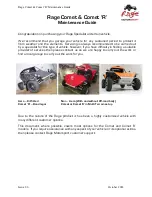
19
Battery Information
• Your Motorized Pool Lounger uses six D batteries,
not included.
• Do not mix alkaline, standard (carbon-zinc) or
rechargeable nickel-cadmium) batteries.
• Do not mix old and new batteries.
• Do not use rechargeable batteries.
• Remove exhausted batteries from the unit.
• Do not short circuit battery terminals.
• Remove batteries and store them in a cool,
dry place when not in use.
• To avoid explosion or leakage, do not dispose of
batteries in a fire or attempt to recharge alkaline
or other non-rechargeable batteries.
Special Care & Handling
• Avoid rough handling such as bumping or dropping.
• Avoid extreme temperatures. For best results use between
the temperatures of 39° F and 120° F (4° C and 38° C).
• Clean using only a slightly damp cloth. Do not
use cleaners with chemical agents.
T
HE
M
OTORIZED
P
OOL
L
OUNGER IS
NEITHER A PERSONAL
-
FLOTATION NOR A
LIFE
-
SAVING DEVICE
. A
LL USERS SHOULD
KNOW HOW TO SWIM
.
18
This device complies with Part 15 of the FCC Rules. Operation is subject to the fol-
lowing two conditions: (1) this device may not cause harmful interference, and (2) this
device must accept any interference received, including interference that may cause unde-
sired operation.
NOTE: This equipment has been tested and found to comply with the limits for a Class
B digital device, pursuant to Part 15 of the FCC Rules. These limits are designed to
provide reasonable l interference in a residential installation. This equipment generates,
uses and can radiate radio frequency energy and, if not installed and used in accor-
dance with the instructions, may cause harmful interference to radio communications.
However, there is no guarantee that interference will not occur in a particular installa-
tion. If this equipment does cause harmful interference to radio or television reception,
which can be determined by turning the equipment off and on, the user is encouraged
to try to correct the interference by one or more
of the following measures:
• Reorient or relocate the receiving antenna.
• Increase the separation between the equipment and receiver.
• Connect the equipment into an outlet on a circuit different from that to which the
receiver is connected.
• Consult the dealer or an experienced radio/TV technician for help.































